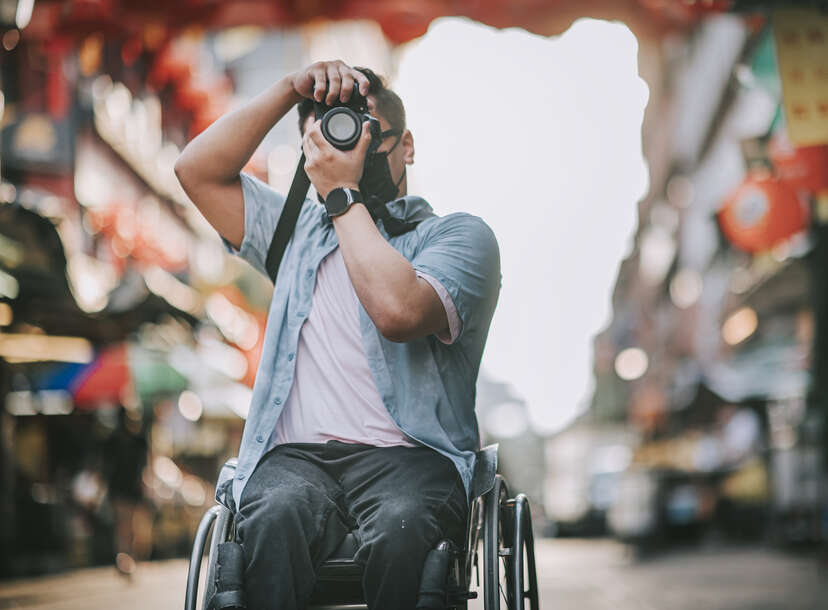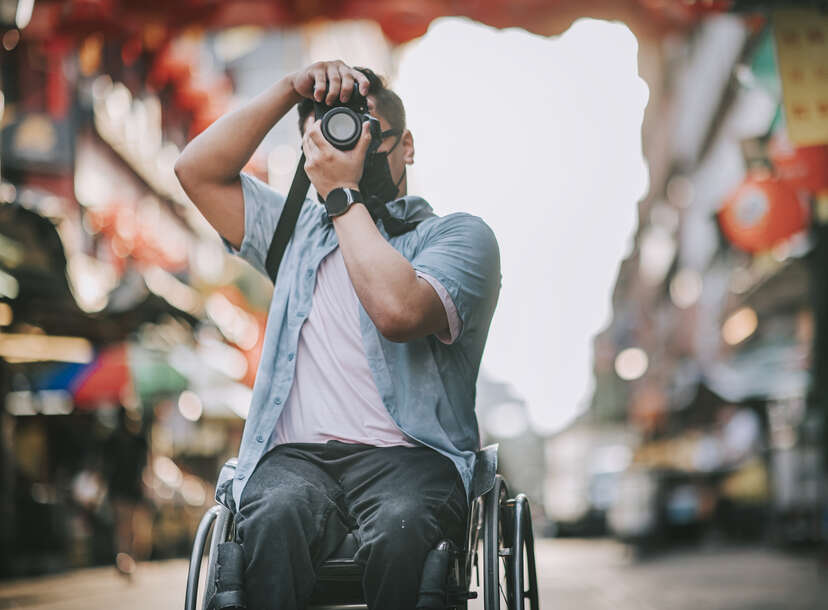Travel still has challenges when it comes to accessibility.
Published June 27, 2023 at 11:17am Edwin Tan/E+/Getty Images
Edwin Tan/E+/Getty Images
If you’ve spent any time on TikTok, you’ve probably seen videos of travelers blaming airlines for damaging their wheelchairs. This is an unfortunately widespread problem, but it’s just one of the reasons why traveling for people with disabilities is difficult and complicated.
According to data from the Americans with Disabilities Act (ADA) National Network, 54 million Americans live with a disability. These citizens work, live, thrive, and vacation in the same spaces as their non-disabled counterparts. My family is part of that statistic. We frequently travel to destinations that are not designed for travelers with disabilities, and it can be exhausting. At the same time, I am encouraged by the number of destinations that are working hard to be more accommodating. While the ADA provides a set of federal guidelines for disability access, it has long been criticized for not going far enough. Beyond required ramps, door widths, and restroom cubicles, travelers with disabilities want and have the right to experience the same things as their non-disabled counterparts.
We found plenty of resources to help us navigate traveling with disabilities. We spoke with Southwest Airlines and TSA representatives before a recent flight and were able to receive most of the accommodations our family needed. And our local airport, Pittsburgh Intercontinental Airport, even has a sensory room with a mock cabin and therapy dogs so neurodiverse and anxious travelers can practice boarding and disembarking procedures. Before heading to Walt Disney World, a Facebook group told us how to get disability access passes for our kids. At the Kennedy Space Center, the whole family was able to enjoy the day together thanks to social stories and other accommodations. We even participated in the disability skiing program on some of our trips.
These all-inclusive outdoor adventures are perfect for hitting the trail
You don’t have to be a hardcore hiker to enjoy nature.
There has also been official progress: In 2022, the Department of Transport published the first-ever bill on the rights of travelers with disabilities, providing clear guidelines on accommodations for both airlines and passengers.
Despite these advances, the travel industry has much work to do, and I asked some travel professionals with disabilities to tell me about their work in this field.
54 million Americans live with a disability. | Halfpoint/iStock/Getty Images Plus/Getty Images
Where do you need improvement?
Jamie Santillo is a travel agent and destination consultant who runs Adventures by Jamie, and she also uses a power wheelchair to get around.
“My disability doesn’t limit where I can travel or the types of adventures I can have — ziplining, airboating, indoor skydiving — but some destinations require a lot more planning time and research,” she says.
But, she says, “you can’t get angry at non-disabled people for not seeing these challenges, because these seemingly simple things will never be an issue if you or anyone you know isn’t in the disability community.” One example she likes to use is the placement of trash cans. “Most hotels, cruise ships, and airports place trash cans or planters directly under the elevator buttons,” she explains. This makes it impossible for travelers who use wheelchairs to press the elevator buttons.
“I think when I say this, people notice it everywhere,” she says, and she’s not wrong.
In her work as a consultant, Santillo encourages destinations to get more comfortable asking awkward questions. “For example, you wouldn’t need to ask a non-disabled traveler how to use the bathroom or how to get in and out of bed,” she says. “For a traveler with a physical disability, these questions are a must.”
“It’s not her disability that limits what she can do, it’s the lack of appropriate facilities that limits her.”
Dr. Rosemary Rosetti is a disability inclusion expert who works in residential and commercial design and as a consultant to destination marketing organizations and tourism boards. She explains that a lack of information about the accommodations a destination offers can make planning a trip difficult. “Destinations need to feature more photos of people with disabilities in their locations to show they are welcoming to people with disabilities,” she says. “Websites should feature photos and descriptions of accessible hotel rooms, and the features that make those rooms accessible.” She would like to see inclusion become central to destination marketing and practices, rather than treated as an afterthought.
Jamie Davis-Smith, a travel journalist whose teenage daughter uses a wheelchair, says that even when accommodations are available, accessing them is often a hassle: “Airlines frequently break wheelchairs, planes don’t have accessible restrooms, and it’s hard to find accessible attractions. And even when attractions are accessible, it often means a lot of extra work to enjoy them, like waiting in long lines to buy passes or finding an accessible entrance.”
It’s also expensive, she explains: “There’s a significant ‘disability tax’. For example, public transportation isn’t available in some places, so you’re forced to take a taxi. Budget hotels don’t have elevators, so you have to go to a more expensive one. The only ADA-compliant room on a cruise ship may be a luxury room with a balcony. This puts cruising out of reach.”
As a mother, Smith says what’s most frustrating is knowing what her child is missing out on: “It’s not her disability that’s limiting her, it’s the lack of proper equipment that’s limiting her.”
Travelers with disabilities are speaking out, and the industry is starting to listen
While it’s clear that the tourism industry still has a long way to go when it comes to serving travelers with disabilities, many destinations are now seeking the services of disability travel experts to improve their guest experience. They’re realizing that it’s not only necessary, but that it’s actually good for business.
According to the U.S. Travel Association, hotels see a surge in bookings when they work to obtain disability travel certification. Dana Young, president and CEO of Visit Florida, says they received overwhelmingly positive feedback after launching a disability travel hub and a video series about activities people with various disabilities can enjoy. “Among the groups Visit Florida markets to, travelers with accessibility needs have experienced the most positive changes in their perceptions of specific destination attributes. For example, they are 30% more likely to recommend Florida as good value for money, 27% more likely to say thinking about Florida makes them happy, and 23% more likely to say, ‘Florida is a destination for people like me.'”
Delta Air Lines develops new wheelchair-accessible airplane seats
The prototypes must be certified and tested before being installed on aircraft.
Located just outside Washington, DC, Visit Loudoun is focused on improving access to historic Leesburg, Virginia, and the surrounding countryside. President and CEO Beth Erickson says her own travel considerations help her think critically about the needs of guests with disabilities. “As avid travelers, we do extensive research to understand what the experience will be like once we arrive at a destination. Will transportation be easy to access? What will the accommodations be like? Will we feel welcome and safe?” she says. “Travelers with disabilities are looking for the exact same kind of information, but through the lens of their needs. Understanding those needs and sharing that information with the hospitality industry is a key part of our work.”Rosetti provides consulting services to the region to help Erikson and her team achieve this goal.
In Ocean City, Maryland, the tourism bureau is seriously considering how to make beach and boardwalk attractions accessible to all visitors, says Jessica Waters, director of marketing and communications. The sand can be difficult to walk on, especially for wheelchair users, so the city has purchased resources to help. “We want to provide a place full of joy, freedom and endless possibilities for people with disabilities. We provide beach mats and beach wheelchairs, and we also have wide sidewalks in key locations.” There are 24 ADA-compliant beach access points along the city’s 10 miles of beach. Continuing to improve the experience for visitors with disabilities requires ongoing work and consultation.
Inside the first art gallery for visually impaired artists and audiences
Feel free to check out the artwork at Envision Arts Gallery in Wichita, Kansas.
These are just a handful of destination marketing organizations that are quickly regaining ground in a sector that has long been ignored. Santillo says destinations are seeing signs that things are getting worse and he’s happy to be part of a new wave of disability awareness in the travel industry.
“Adults with disabilities spend $58 billion a year on travel,” she told me. “We are a community that wants to see the world.”
Want more Thrillist? Follow us on Instagram and TikTok. twitterFacebook, Pinterest, YouTube, etc.
Meg St-Esprit is a Thrillist contributor.
Source link

